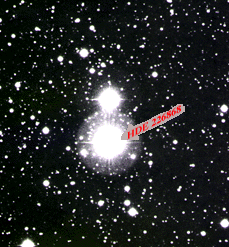

Or, solving for R:

A calculation using general relativity gives the same answer, that for a collapsed object light cannot escape from within that radius, called the Schwarzschild radius.
And we are now in the heart of general relativity....
Nothing can escape from within the Schwarzschild radius -- we can never know what happens inside. Note that this is not the size of the black hole. The black hole has no size, it has collapsed into a singularity. But we often refer to the Schwarzchild radius as the black hole's size.
Huh? We just nothing escapes from inside a black hole!Pair production.
Inside a black hole, particles are constantly transforming back and forth between energy and mass. For example, electron-positron pairs:So black holes can lose mass and dissolve, but the timescales are long. For a solar mass black hole, the evaporation time is 1066 years. Very low mass primordial black holes would have shorter evaporation times, 15 billion years, and give a burst of high energy gamma rays and atomic particles. None have been observed, though....If this happens just inside the Schwarzchild radius, one of the gamma rays may be created just outside the Schwarzchild radius, where it can escape and take the rest mass of the electron with it. This is referred to Hawking radiation.
How much energy is released when that mass falls onto the primary star?
Let's take a piece of mass (m) and drop it on a star of radius R and mass M from infinity. Then

And since energy is conserved, when it hits the surface of the star it has kinetic energy

Example: 1 gm of hydrogen dropped on a white dwarf (M=0.85 Msun, R=0.01Rsun): K=1.7x1017 ergs. Compare this to how much energy would be released if we fused that hydrogen into helium: 0.007mc2 = 6.3x1018 ergs.
But what if we dropped that hydrogen on a neutron star (M=1.4 Msun, R=10 km)? K=1.9x1020 ergs! Wow!!
Mass transfer can release immense amounts of energy!
|
|
|
|
|
|
|
|
|
|
|
|
|
|
|
|
| Example: Cygnus
X-1
Binary Star w/ two objects:
|
 |